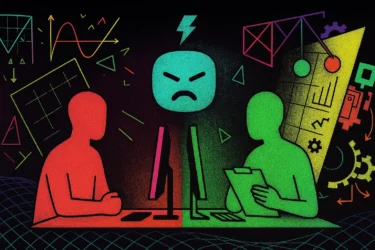Researchers claim to have used artificial intelligence to find out who started the QAnon movement.
Since 2017, one or more individuals have been spreading crude conspiracy theories under the pseudonym Q. What began in the form of obscure forum postings quickly grew into a national movement. According to a March 2021 poll, 15 to 20 percent of U.S. citizens believe in Q's theories of a Democratic elite pulling strings behind the scenes and kidnapping children.
It is not known who authored the messages published between October 2017 and December 2020. The person behind Q claimed to be a high-ranking military officer with close ties to the Trump administration. Two teams of researchers now claim to have independently found evidence of Q's true originators, The New York Times writes.
QAnon's beginnings
According to the report, Paul Furber first came to prominence as "Q". Furber is a South African software developer with a penchant for conspiracy theories, who, as it later turned out, made the anonymous posts known among like-minded people and thus contributed significantly to their spread in the early days.
As Q's postings became more widely heard, Trump supporter and co-operator of the controversial Internet forum 8chan (now 8kun) Ron Watkins reportedly took over Q's role. Since the beginning of 2018, the posts were published on the infamous imageboard, which brought it rapidly growing traffic.
Furber later accused Watkins of appropriating Q's identity. Watkins is currently running for a seat in the U.S. Congress. His campaign is funded by donations from QAnon supporters.
High hit probability
The two research teams, consisting of Claude-Alain Roten and Lionel Pousaz of Swiss startup OrphAnalytics and French computational linguists Florian Cafiero and Jean-Baptiste Camps, claim to have independently found evidence of Q's authorship.
In their investigation, they relied on methods of stylometry, a discipline used in forensics and other fields that analyzes and compares speech styles using mathematics and statistics. According to the New York Times, both studies used machine learning to find matches between Q's texts and those of suspected authors, including Paul Furber and Ron Watkins.
The Swiss team reports the accuracy of their results at 93 percent. The French researchers are even more certain, estimating 98 percent in Furber's case and 99 percent in Watkins'. When asked by the newspaper, both denied having impersonated Q.
Experts: AI findings are "convincing
The New York Times had the findings reviewed by two renowned stylometry experts, who rated the results as credible and convincing.
“What’s really powerful is the fact that both of the two independent analyses showed the same overall pattern,” said Duquesne University computer science professor Patrick Juola. Juola used stylometrics to uncover that Harry Potter author J.K. Rowling published the novel Cuckoo's Calling under a pseudonym.
The researchers see their findings as the first empirical evidence that Furber and Watkins were behind Q and launched the movement. They hope that unmasking the originators will help break the spell of the QAnon myth.







